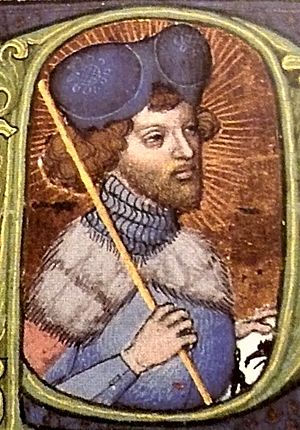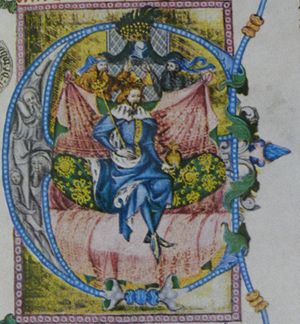Wenceslaus IV of Bohemia facts for kids
Quick facts for kids Wenceslaus IV |
|
|---|---|

Detail from the Wenceslas Bible, 1390s
|
|
| King of Bohemia | |
| Reign | 29 November 1378 – 16 August 1419 |
| Coronation | 15 June 1363 St. Vitus Cathedral, Prague |
| Predecessor | Charles IV |
| Successor | Sigismund |
| King of Germany | |
| Reign | 10 June 1376 – 20 August 1400 |
| Coronation | 6 July 1376 Aachen Cathedral |
| Predecessor | Charles IV |
| Successor | Rupert |
| Born | 26 February 1361 Nuremberg, Kingdom of Germany, Holy Roman Empire |
| Died | 16 August 1419 (aged 58) Kunratice, Prague, Bohemia |
| Burial | St. Vitus Cathedral, Prague |
| Spouse |
|
| House | Luxembourg |
| Father | Charles IV, Holy Roman Emperor |
| Mother | Anna von Schweidnitz |
Wenceslaus IV (also Wenceslas; Czech: Václav; German: Wenzel), sometimes called "the Idle," was born on February 26, 1361. He was also known as Wenceslaus of Luxembourg. He became King of Bohemia in 1378 and ruled until his death on August 16, 1419. He was also King of Germany from 1376 until he was removed from power in 1400. Wenceslaus was part of the House of Luxembourg, a powerful royal family. He also served as Duke of Luxembourg from 1383 to 1388.
Contents
Becoming King: Wenceslaus' Early Life
Wenceslaus was born in Nuremberg, an important city in the Holy Roman Empire. His father was Emperor Charles IV, and his mother was Anna von Schweidnitz. He was baptized at St. Sebaldus Church.
When Wenceslaus was just two years old, his father had him crowned King of Bohemia in June 1363. This was a way to secure his future power. In 1373, his father also helped him gain control of the Margraviate of Brandenburg, another important territory.
On June 10, 1376, Charles IV made sure Wenceslaus was chosen as King of the Romans. This was a title often given to the future Holy Roman Emperor. Wenceslaus was crowned in Aix-la-Chapelle (now Aachen) on July 6.
Challenges for Charles IV
To help Wenceslaus get elected, Charles IV took back special rights from many Imperial Cities. He had given these rights to the cities earlier. He also used these cities as collateral for loans from nobles.
However, these cities were not weak. They had grown into strong military forces. Charles IV had also organized them into leagues, which allowed them to work together. For example, on July 4, 1376, fourteen cities in Swabia formed the Swabian League of Cities. They did this to protect their rights against the new King Wenceslaus. This league soon grew and acted like its own state until 1389.
Wenceslaus' Rule as King
Wenceslaus started helping his father with government duties before Charles IV died. When his father passed away in 1378, Wenceslaus inherited the Crown of Bohemia. He also became the ruler of the Holy Roman Empire.
Dealing with City Leagues
In 1387, a fight broke out between Frederick, Duke of Bavaria, and the cities of the Swabian League. This led to a big war in Swabia. The cities were weaker because they were isolated and had their own disagreements. They were defeated by the forces of Eberhard II, Count of Württemberg, in 1388.
Many cities accepted Wenceslaus' decision in 1389. He said that cities could not form leagues with each other, but he confirmed their political freedom. This brought some peace for a few decades. However, the cities stopped being a strong support for the central Imperial government.
King of Bohemia: Challenges and Conflicts
During his time as king, Wenceslaus struggled to keep control. He often had conflicts with the nobles in Bohemia, especially the powerful House of Rosenberg. He was even imprisoned twice by these rebellious nobles.
Wenceslaus' own family also caused problems. His father, Charles IV, had divided his lands among his sons and relatives. Wenceslaus kept Bohemia, but his younger half-brother Sigismund received Brandenburg. His cousin Jobst and Procopius shared the March of Moravia. This meant Wenceslaus did not have as many resources as his father had. However, he did inherit the Duchy of Luxembourg from his uncle in 1383. In 1386, Sigismund became king of Hungary, which led him to focus on eastern affairs.
Wenceslaus also faced strong opposition from Bohemian nobles and even from his own chancellor, the Prague archbishop Jan of Jenštejn. In 1393, a conflict about choosing an abbot led to the torture and murder of the archbishop's vicar-general, John of Nepomuk. This event caused a rebellion by the nobles. In 1394, Wenceslaus' cousin Jobst of Moravia was made regent (a temporary ruler), and Wenceslaus was arrested.
King Sigismund of Hungary helped arrange a truce in 1396. Because of his efforts, Sigismund was recognized as the person who would inherit Wenceslaus' throne.
Religious Issues and Jan Hus
During the Western Schism, a time when there were rival popes, Wenceslaus supported Pope Urban VI in Rome. As King of Bohemia, he tried to protect the religious reformer Jan Hus and his followers. The Roman Catholic Church wanted to stop Hus, calling his ideas heretical. This led many Germans to leave the University of Prague and start their own university in Leipzig.
Wenceslaus also met with Charles VI of France to try and end the papal schism. They wanted the rival popes to resign so a new one could be elected. Many princes were angry that Wenceslaus abandoned Pope Boniface. They were also upset because Wenceslaus was often away from Germany and had sold the title of duke of Milan to Gian Galeazzo Visconti.
Jan Hus was eventually executed in Konstanz in 1415. The rest of Wenceslaus' reign in Bohemia saw events that led to the Hussite Wars. These wars happened after his death and were about calls for religious reform by Jan Hus. They were sparked by public anger over Hus' execution.
Being Removed from Power: Wenceslaus' Dethronement
Because of his problems in Bohemia, Wenceslaus did not try to be crowned Holy Roman Emperor. This made people angry at the Reichstag (Imperial Diet) meetings in Nuremberg (1397) and Frankfurt (1398). Four important electors from the Rhineland, including Rupert III and the archbishops of Mainz, Cologne, and Trier, accused him of not keeping peace or solving the Papal Schism.
They demanded that Wenceslaus appear before them in June 1400. Wenceslaus did not go, mainly because of new fights in Bohemia. When he failed to appear, the electors met at Lahneck Castle. On August 20, 1400, they declared him removed from power. They said he was "futile, idle, negligent and ignoble." The next day, they chose Rupert as their new king. Wenceslaus did not accept Rupert's rule, but he did not try to fight him either.
Imprisonment and Escape
On June 29, 1402, Wenceslaus was captured by Sigismund. Sigismund first planned to take him to Rome to be crowned emperor. But Rupert heard about this plan and tried to stop them. So, Sigismund imprisoned Wenceslaus, first in Schaumberg, and then in Vienna starting August 16. He was held by William, Duke of Austria.
On November 20, Wenceslaus was forced to sign away all his powers to Sigismund and the Dukes of Austria. In return, his imprisonment conditions became easier.
In early 1403, Rupert tried to make a deal with Sigismund. He wanted Sigismund to give up his plan to become emperor. But Sigismund invaded Bohemia with Hungarian forces. He looted and charged high taxes. He also went after Wenceslaus' supporters. Sigismund even took money from the royal treasury to pay for his military fights against Rupert and Jobst of Moravia.
A truce was agreed between Sigismund and Jobst from April 14 to May 20. This gave Sigismund's enemies time to prepare. After the truce ended, Sigismund could not gain any more ground. He left Bohemia and reached Bratislava on July 24.
On October 1, 1403, Pope Boniface IX finally agreed that Wenceslaus had been removed from power. He also recognized Rupert as King of the Romans. Since Wenceslaus could no longer be crowned emperor, and even though he was still technically a prisoner in Vienna, he was not strictly guarded. He managed to escape on November 11.
He crossed the Danube River and was helped by John II of Liechtenstein. He went through Mikulov back to Bohemia. He met his supporters in Kutná Hora before going to Prague, which he entered on Christmas.
Resolving the Schism and Succession
One of the reasons Rupert gave for removing Wenceslaus was the Papal Schism. King Rupert called the Council of Pisa in 1409. People from both papal sides attended. They elected Antipope Alexander V, but this made things worse. He was not recognized by the other two popes, so from 1409 to 1417, there were three popes.
After Rupert died in 1410, it was hard to decide who would rule next. Both Wenceslaus' cousin Jobst of Moravia and Wenceslaus' brother Sigismund of Hungary were elected King of the Romans. Wenceslaus himself had never accepted being removed from power, so he still claimed the kingship.
Jobst died in 1411. Wenceslaus then agreed to give up the crown, as long as he could keep Bohemia. This settled the issue. After 1411, Sigismund ruled as king and later became Holy Roman Emperor.
Church leaders were tired of the Great Schism. They supported Sigismund when he called the Council of Constance in 1414. The council's goal was to fix problems in the church. In 1417, the council removed all three popes and elected a new one. By solving the schism, Sigismund brought honor back to the imperial title. He became the most important ruler in the west.
Wenceslaus' Personal Life
Wenceslaus was married two times. His first wife was Joanna of Bavaria, from the Wittelsbach family. They married on September 29, 1370. She died on December 31, 1386. After her death, he married her cousin, Sofia of Bavaria, on May 2, 1389. Wenceslaus did not have any children with either wife.
Wenceslaus was known to be a very knowledgeable man. He is famous for the Wenceslas Bible, a beautifully illuminated manuscript (a book with drawings and decorations) that he had made between 1390 and 1400.
However, his rule was often unstable. He sometimes seemed lazy and other times acted very cruelly, like in the case of John of Nepomuk. Unlike his father, Wenceslaus showed favoritism, which made many nobles dislike him and led to him becoming isolated.
Wenceslaus died in 1419 from a heart attack. He was hunting near his castle in Kunratice (now part of Prague). His death left the country in a big political crisis. This was followed by almost two decades of fighting called the Hussite Wars. These wars were about calls for religious reform by Jan Hus and were sparked by public anger over his execution.
See also
 In Spanish: Wenceslao de Luxemburgo para niños
In Spanish: Wenceslao de Luxemburgo para niños
- List of rulers of Bohemia
- Kings of Germany family tree
- Decree of Kutná Hora



